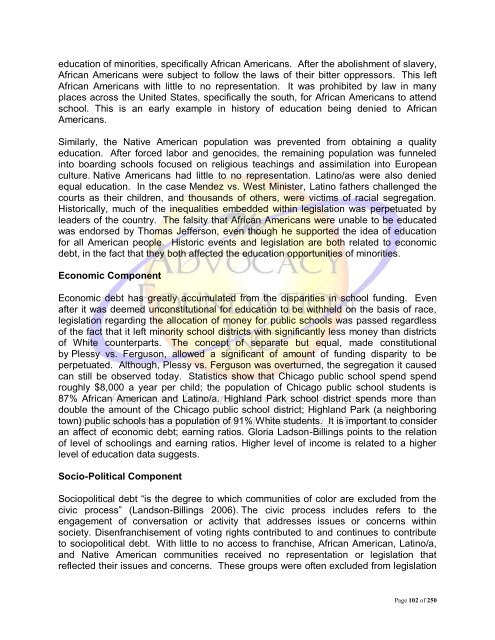Institutional Racism
Institutional Racism
Institutional Racism
Create successful ePaper yourself
Turn your PDF publications into a flip-book with our unique Google optimized e-Paper software.
education of minorities, specifically African Americans. After the abolishment of slavery,<br />
African Americans were subject to follow the laws of their bitter oppressors. This left<br />
African Americans with little to no representation. It was prohibited by law in many<br />
places across the United States, specifically the south, for African Americans to attend<br />
school. This is an early example in history of education being denied to African<br />
Americans.<br />
Similarly, the Native American population was prevented from obtaining a quality<br />
education. After forced labor and genocides, the remaining population was funneled<br />
into boarding schools focused on religious teachings and assimilation into European<br />
culture. Native Americans had little to no representation. Latino/as were also denied<br />
equal education. In the case Mendez vs. West Minister, Latino fathers challenged the<br />
courts as their children, and thousands of others, were victims of racial segregation.<br />
Historically, much of the inequalities embedded within legislation was perpetuated by<br />
leaders of the country. The falsity that African Americans were unable to be educated<br />
was endorsed by Thomas Jefferson, even though he supported the idea of education<br />
for all American people. Historic events and legislation are both related to economic<br />
debt, in the fact that they both affected the education opportunities of minorities.<br />
Economic Component<br />
Economic debt has greatly accumulated from the disparities in school funding. Even<br />
after it was deemed unconstitutional for education to be withheld on the basis of race,<br />
legislation regarding the allocation of money for public schools was passed regardless<br />
of the fact that it left minority school districts with significantly less money than districts<br />
of White counterparts. The concept of separate but equal, made constitutional<br />
by Plessy vs. Ferguson, allowed a significant of amount of funding disparity to be<br />
perpetuated. Although, Plessy vs. Ferguson was overturned, the segregation it caused<br />
can still be observed today. Statistics show that Chicago public school spend spend<br />
roughly $8,000 a year per child; the population of Chicago public school students is<br />
87% African American and Latino/a. Highland Park school district spends more than<br />
double the amount of the Chicago public school district; Highland Park (a neighboring<br />
town) public schools has a population of 91% White students. It is important to consider<br />
an affect of economic debt; earning ratios. Gloria Ladson-Billings points to the relation<br />
of level of schoolings and earning ratios. Higher level of income is related to a higher<br />
level of education data suggests.<br />
Socio-Political Component<br />
Sociopolitical debt “is the degree to which communities of color are excluded from the<br />
civic process” (Landson-Billings 2006). The civic process includes refers to the<br />
engagement of conversation or activity that addresses issues or concerns within<br />
society. Disenfranchisement of voting rights contributed to and continues to contribute<br />
to sociopolitical debt. With little to no access to franchise, African American, Latino/a,<br />
and Native American communities received no representation or legislation that<br />
reflected their issues and concerns. These groups were often excluded from legislation<br />
Page 102 of 250

















